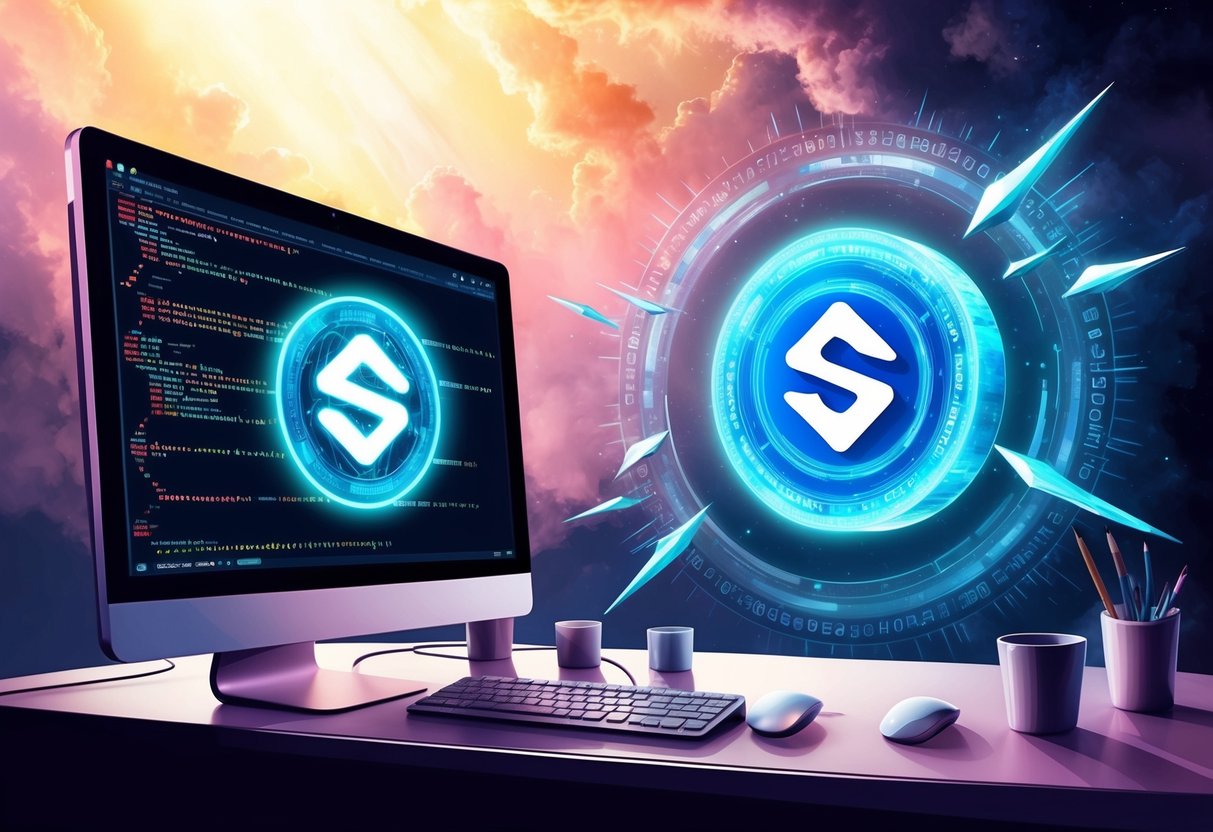Anyone can create a crypto coin on Solana using easy-to-follow steps, making it possible for beginners and experts to launch their own digital asset. Solana’s fast speeds and low costs have made it a popular choice for new tokens and projects. With the right tools and some basic planning, people can bring their crypto ideas to life on this blockchain.

There’s no need for deep coding skills since platforms and guides walk users through the process. The main steps include connecting a wallet, filling in token details, and confirming the creation, often for a small fee. For those interested in new opportunities, the Nollars Network presale is open and may offer extra value for early supporters.
Key Takeaways
- Solana lets anyone make a new crypto coin easily
- Clear steps and helpful guides make the process simple
- Users should plan ahead and watch new projects like Nollars Network
Understanding Solana and Blockchain Technology
Solana is a high-speed blockchain that supports fast transactions with low fees. This makes it popular for creating tokens and decentralized apps. Comparing Solana with other chains like Ethereum and Bitcoin shows clear differences in speed, fees, and design.
What Is Solana?
Solana is a layer-1 blockchain built for scalable and decentralized applications. It can process thousands of transactions per second (TPS) thanks to its unique design. This makes it much faster than many older blockchains. Fees on Solana are very low, so users can move or create tokens without high costs.
Developers use Solana to create tokens, run smart contracts, and launch projects. The network uses advanced cryptography and new methods to stay secure. You can learn more about the basics of how Solana works through Solana’s official guide.
Solana vs. Ethereum and Bitcoin
The three chains—Solana, Ethereum, and Bitcoin—are all popular, but they differ in important ways:
| Feature | Solana | Ethereum | Bitcoin |
|---|---|---|---|
| Speed (TPS) | 2,000+ | ~30 | ~7 |
| Main Use | Apps, tokens, games | Apps, tokens | Payments |
| Fees | Very low | Often high | Low to high |
| Consensus | PoS, PoH | PoS (with ETH 2.0) | PoW |
| Smart Contracts | Yes | Yes | Limited |
Solana can handle more transactions per second than Ethereum and Bitcoin. It uses lower fees, so it is well-suited for fast and cheap token creation. Ethereum is known for its smart contracts, but it has slower speeds and higher costs. Bitcoin mainly supports payments, not complex apps or tokens. For further comparison, Investopedia’s overview of Solana lays out core differences between these major blockchains.
Proof of Stake and Proof of History Explained
Proof of Stake (PoS) and Proof of History (PoH) set Solana apart from older blockchains. PoS is a way for the network to choose who proposes the next block based on how many coins a person holds and “stakes.” This uses less energy and allows faster confirmation than Proof of Work, used by Bitcoin.
PoH is an extra system unique to Solana—it acts like a cryptographic clock. This lets all nodes agree on the order of events quickly without waiting for others’ timestamps. The combination of PoS and PoH increases speed, cuts fees, and boosts scalability.
Solana’s technical design makes it stand out for anyone wanting to make a token quickly and affordably compared to other major blockchains.
Preparing to Launch a Crypto Coin on Solana
Before creating a new cryptocurrency on Solana, it is important to have the right wallet setup, select appropriate development tools, and clearly define the purpose and economics of the token. Each step requires attention to detail to avoid mistakes with digital assets and transactions.
Wallet Setup and Funding SOL
A Solana-compatible wallet is necessary to manage tokens and process network transactions. Phantom and Solflare are popular wallet options. After installing a wallet, the user will need to create and securely back up their wallet’s secret recovery phrase.
Owning SOL, the native token of Solana, is required to cover transaction fees. Adding SOL can be done by buying from a supported exchange and transferring it to the wallet. The recommended starting amount varies, but having at least 0.1 to 1 SOL helps with test transactions and future coin launches.
Make sure to check transaction fees. Solana fees are usually very low—often less than $0.01 per transaction. Having enough SOL is critical for deploying programs, transferring tokens, and managing the new coin.
Selecting Development Tools
To create a crypto coin on Solana, using the right tools makes development smoother. The Solana CLI (Command Line Interface) is essential for creating accounts, managing programs, and sending transactions.
Other tools like Solana Program Library (SPL) Token CLI help mint and handle tokens. Visual Studio Code or similar code editors are useful for writing and editing program files. For those who prefer not to code, online solutions such as the SmithiiSolana Token Creator offer guided token creation.
Testing on the Devnet (test network) before using the Mainnet is highly encouraged. This approach reduces risk and helps detect issues before any real SOL is spent.
Defining Utility and Tokenomics
Designing the new token’s utility and economic structure (tokenomics) is central to its success. The creator should decide if the token will be for trading, rewards, governance, or other specific uses in a portfolio.
Key aspects to outline include:
- Maximum and initial supply of tokens
- How tokens will be distributed
- Whether the token can be staked, or used in programs for rewards
- What makes the token attractive to potential users and traders
It is also useful to highlight how volatility may impact coin value and what steps are in place to handle this. Clear, transparent documentation on tokenomics helps build trust within the cryptocurrency community. This foundation is important for attracting interest and supporting future trading activities.
Step-by-Step Guide to Creating a Solana Coin
Making a coin on Solana includes writing a smart contract, deploying the token, and getting verified on places like CoinMarketCap. Each part has important steps and tools to use, including working with Solana CLI and validators for blockchain security.
Smart Contract Development
On Solana, coins are created as tokens using smart contracts called programs. Developers often use the SPL Token program, which is standard for creating tokens on Solana. No need to write a smart contract from scratch unless custom rules are needed.
Start by installing the Solana CLI and configuring it with a funded wallet. The CLI allows you to create new tokens with a single command. Each token uses lamports, Solana’s smallest unit, to pay for blockchain transaction fees.
Here’s a sample process:
- Install Solana CLI and set up your wallet.
- Use
solana-tokens create-tokento make your new token. - Create a token account to hold balances.
- Set token supply and mint authority.
For a detailed breakdown, check out the official Solana token creation guide.
Deploying Your Token
Once the token is created, the next step is to deploy and distribute it. Deployment means the token’s details and supply are registered and live on the Solana blockchain. Validators will now process any transactions involving this token, ensuring network security.
Distribute initial tokens by minting them to your own wallet or others. This is also the point when you can add metadata, such as the token’s name, symbol, and logo, using the Solana Token Metadata program.
A simple deployment checklist:
- Confirm token creation and token account setup.
- Mint initial supply to specified recipients.
- Add metadata for better recognition on explorers.
- Optionally, use launchpads or platforms to help with distribution, as shown in some user-friendly guides.
Verifying on CoinMarketCap
To list your newly created token on CoinMarketCap, the token must be verified first. This helps users find real information about your coin.
Prepare these details before applying:
- Contract address of the token
- Project website and official links
- Whitepaper or project overview
- Total supply and distribution breakdown
- Explorer page (for example, using Solscan)
Submit your token information through the CoinMarketCap application process. They will review and ensure the data matches the Solana blockchain records processed by validators.
After approval, your token will appear on CoinMarketCap, letting more people see and research it.
Key Considerations for Launch and Beyond

Launching a crypto coin on Solana involves more than just the technical steps. Ongoing security, legal steps, and community support will determine the project’s real success.
Security and Compliance
Security starts with protecting private keys and using secure wallets. Coin creators should use two-factor authentication and cold storage for key management. Code for smart contracts and decentralized applications (dApps) must be audited to reduce the risk of hacks or exploits.
Regulatory compliance is also important. The team should check if their token follows local laws, such as KYC/AML regulations, since non-compliance can lead to legal issues. If the coin involves decentralized finance (DeFi) tools like staking or lending, extra care is needed because these tools are frequent targets for attackers and are often regulated.
It is vital to publish clear terms for staking rewards. Users need to know how rewards are calculated, any fees, and the process for claiming them. Transparent policies build trust and lower the risk of disputes.
Community Building and Marketing
A strong community drives adoption, trading volume, and long-term value. Teams should open social channels like Discord, Twitter, and Telegram for real-time updates and discussion. Holding ask-me-anything (AMA) sessions and providing regular news boosts user engagement.
To grow the user base, clear educational content makes the project easier to understand. Tutorials on using DeFi features, how to claim staking rewards, and regular updates keep people interested. Transparent communication about risks and progress helps retain trust.
Giveaways, partnerships, and listing on token indexes or swap platforms can also help attract early supporters. Consistent and honest updates, even during setbacks, are key for long-term success. Community voting or feedback sessions help users feel involved and valued, which is essential for cryptocurrency projects.
Use Cases and Applications for Solana Coins
Solana coins help power many digital products and services. They are used to move value quickly, improve access to decentralized finance, and enable new ways to interact with games and collectibles.
DeFi and Payments
Solana supports high transaction throughput, processing thousands of transactions per second. This speed is important for payment systems and decentralized applications like lending or trading.
Many users create coins to join the DeFi ecosystem, where tokens can be staked in liquidity pools or used as collateral for loans. Staking lets holders earn rewards while helping secure the network.
Some platforms let people use Solana-based tokens to pay for goods or services. Companies like Visa and CME Group have explored blockchain for fast payments, showing Solana coins may work well for both ordinary users and businesses.
Solana’s low fees also help make micro-payments more practical. This is useful for streaming, tipping, and small online purchases.
NFTs and Gaming
Many NFTs are made and traded on Solana. NFT marketplaces let users buy, sell, and create unique digital items like art, music, and in-game collectibles.
In gaming, Solana coins power in-game economies. Players can use coins to buy virtual land, trade skins, or earn rewards. These coins help games run without a central authority, so players truly own what they earn.
NFTs built on Solana can be moved from one game or platform to another, thanks to its fast and low-cost transactions. This helps connect different apps and communities into a wider digital world.
Frequently Asked Questions
Making a crypto coin on Solana involves using tools like the Solana CLI and specific wallet software. Costs, steps, and available guides depend on the ways a user chooses to launch their token.
What are the steps involved in creating a new token on the Solana blockchain?
To create a new token, users need to install both the Solana Command Line Interface (CLI) and a wallet such as Phantom. After connecting the wallet, they initialize a token using CLI commands. Next, users create a token account, mint tokens, and manage token details like name and supply. Guides explain these steps using the official Solana developer resources.
Can you create a cryptocurrency token on Solana without any cost, and if so, how?
It is not possible to create a Solana token completely free of cost. At a minimum, users need to pay for transaction fees. According to community guides, simple token creation may require as little as 0.01 SOL, which covers the blockchain fee when creating the token. Online platforms may add small fees for convenience.
What is the estimated cost to develop a custom meme coin on the Solana network?
Creating a simple meme coin on Solana can be done for a low cost, mainly the network fee. For example, the cost is about 0.01 SOL if launching through a standard tool or web app. Extra features or smart contract customizations may raise costs. More info is shared in community posts such as this guide to meme token creation.
What is the process for developing a stablecoin on Solana?
Developing a stablecoin requires setting up the base token, defining collateral, and using smart contracts to maintain price stability. This often involves more advanced programming and audits compared to creating a simple token. Projects must make sure the token keeps a stable value against another asset.
How do you mint your own crypto token from scratch on Solana?
To mint a token from scratch, users first set up the Solana CLI and create a wallet. Then they use commands to generate a new token mint and specify details like total supply. Afterward, they distribute tokens to different accounts as needed. Clarity and control over the process can be achieved with step-by-step instructions from developer guides.
Is there a comprehensive guide available for creating a Solana-based token?
Yes, there are comprehensive guides that cover every step, from setup to token launch. Official Solana developer documentation and third-party tutorials offer simple instructions, screen-by-screen actions, and troubleshooting help. Some online dApps also guide users through token creation using easy forms and wallet connections.




